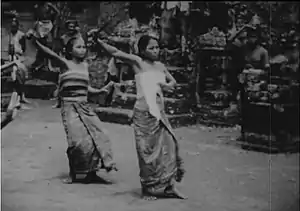Trance and Dance in Bali
Trance and Dance in Bali is a short documentary film shot by the anthropologists Margaret Mead and Gregory Bateson during their visits to Bali in the 1930s. It shows female dancers with sharp daggers dancing in trance, eventually stabbing themselves without injury. The film was not released until 1952. It has attracted comment from later anthropologists for its pioneering achievement, but also for what it does not show.

Significance

In 1999 the film was deemed "culturally significant" by the United States Library of Congress and selected for preservation in the National Film Registry.[1]
The film was "very influential for its time", according to the anthropologist Jordan Katherine Weynand. She states that it records Balinese people "dancing while going through violent trances, stabbing themselves with daggers without injury. They are then restored to consciousness with holy water and incense."[2]
The Indonesian American anthropologist Fatimah Tobing Rony argues that the "photogenic" violence and trance are untranslatable: anthropology can look at trance but never really penetrates its mystery. In her view, "the naughty voices of the girls and the vain chuckles of the old women, transcribed by the secretary, are never heard in the voiceover or soundtrack: the women become undifferentiated exotic trancers. And the spiritual depths of the older women are not considered."[3] As for objectivity, Rony remarks that "The photogenic Trance and Dance in Bali is representative of a kind of anthropological imperialist blindness, ironic considering that these scientists believed [in] and promoted the idea of their own superior vision".[3]
Ira Jacknis records that the film, like Bateson and Mead's other works, initially received a puzzled welcome, but that these became classics, launched the field of visual anthropology, and have "landmark status" with little to compare them to. Most of the footage was shot on 16 December 1937 in a performance that they commissioned (on Mead's birthday). They referenced their payment for the performance to Balinese cultural patronage. The trance ritual that they filmed was, according to Jacknis, "not an ancient form, but had been created during the period of their fieldwork", as a Balinese group had in 1936 "combined the Rangda or Witch play (Tjalonarang) with the Barong and kris-dance play, which was then popularized with tourists through the efforts of [the painter] Walter Spies and his friends." The kris-dance featured women dancers, a custom "first suggested by Bateson and Mead in 1937".[4]
The anthropologist Hildred Geertz calls the film pioneering, writing that Bateson and Mead are more than pathbreakers: their films "remain in certain crucial respects exemplary achievements."[5] In her view, their films are sophisticated "even by today's standards in that they use film not as ethnographic illustration but as a powerful tool in systematic cultural research."[5] Trance and Dance in Bali sets out, Geertz argues, a hypothesis about the interconnectedness of cultural experiences of childhood, ritual, and folk drama. The film is a "minute" sample of Mead's "incredibly large corpus of visual materials", now all archived and annotated. Geertz notes, too, that the film is "a highly dramatic and moving presentation of Balinese culture" that words alone could not achieve, even if the Witch-and-Dragon ritual dance had to be shot in daylight "rather than catching it in all its terrifying mystery" at night.[5]
See also
References
- "Trance and Dance in Bali". Library of Congress. Retrieved 17 October 2018.
- Weynand, Jordan Katherine (8 September 2016). "Margaret Mead & Gregory Bateson". Emory University. Retrieved 17 October 2018.
- Rony, Fatimah Tobing (2006). "The Photogenic Cannot Be Tamed: Margaret Mead and Gregory Bateson's "Trance and Dance in Bali"". Discourse. 28 (1): 5–27. JSTOR 41389738.
- Jacknis, Ira (May 1988). "Margaret Mead and Gregory Bateson in Bali: Their Use of Photography and Film". Cultural Anthropology. 3 (2): 60–177. JSTOR 656349.
- Geertz, Hildred (1976). "Trance and Dance in Bali. Gregory Bateson, Margaret Mead. ; Bathing Babies in Three Cultures. Gregory Bateson, Margaret Mead. ; Karba's First Years. Gregory Bateson, Margaret Mead". American Anthropologist. 78 (3): 725–726. doi:10.1525/aa.1976.78.3.02a01160.